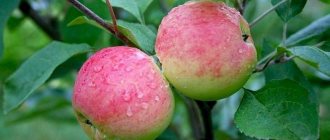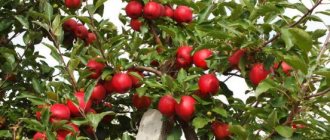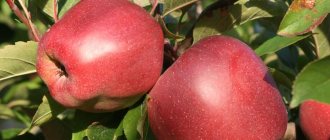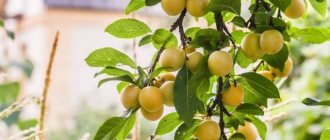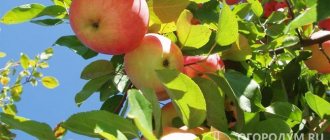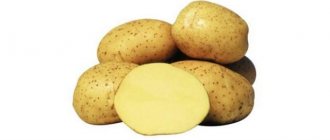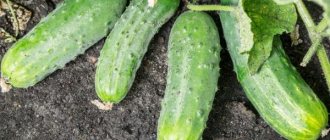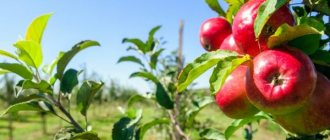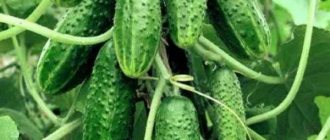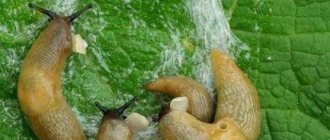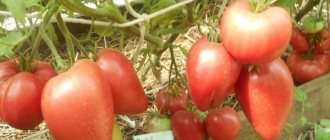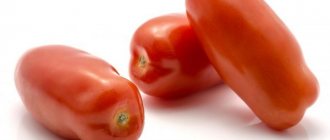Why did I suddenly want to talk about him? But because on February 28th we took out the last 2 fresh apples of the 2021 harvest from the underground and ate them. And according to my standards, this is a phenomenal success!
Dmitry Belkin
Hello, dear readers! Today I want to tell you about one of the apple trees that grows in our garden. This is Spartan.
Why did I suddenly want to talk about him? But because on February 28th we took out the last 2 fresh apples of the 2021 harvest from the underground and ate them. And according to my standards, this is a phenomenal success!
Here are the last two apples of the 2021 harvest. End of February. I apologize for the shadows. Filmed under the low February sun
As you can see, everything is fine! You can eat!
Fruiting
Spartan bears fruit in our country every year. But it doesn’t happen that there are no apples on it at all. It’s just that if one year it’s scattered and there’s nowhere to put it, then the next year there may be 10, 20 or 30 apples on it. That's all. I think it is quite possible to achieve annual fruiting of Spartan. To do this, you need to take good care of it, monitor it, prune it wisely, fertilize it on time and correctly. Especially in the fall.
Spartan fruits of different sizes. There are also big ones. And there are small ones. This, it seemed to us, depends on the amount of sun, the age of the tree and its condition (health). The larger the apple, the tastier it is and the more enjoyable it is to eat. Apples ripening in the sun are completely red and have a dark tint. Apples growing in the shade may have yellow sides. And they're not that sweet.
Spartan is very late. We collect it in October. The fruits up to this point are terribly hard and taste grassy. When ripe, Spartan acquires its phenomenal properties, which make it a leader in our garden. Apples are surprisingly fragrant. They are more sweet than sour. And they are very pleasant to eat. They crunch amazingly on your teeth and when you bite into them, they simply burst out with juice. The skin is hard, but it usually doesn’t scratch the throat (but you have to chew it well, anyway). The pulp is dense and completely white.
additional characteristics
Appearance
The Spartan apple tree is a medium-sized tree with a rounded, flattened crown . The central conductor of the tree grows at a slight angle. The burgundy branches bear small fruits, weighing no more than 150 grams. dark lilac color.
Leaf color and shape
The foliage of the plant is round, with a relief surface, shiny dark green.
Tree height
The apple tree has average growth vigor. Tree height: 5 – 6 m.
Crown width
A large number of branches located at an angle of 70 degrees to the trunk make the crown unusually lush.
The shoots of the apple tree are lilac , with a slight drooping down.
Disadvantages and advantages
Due to its advantages, the variety is very popular among gardeners.
The best indicators are:
- Annual fruiting;
- Taste qualities of fruits;
- Good transportability;
- Resistance to various diseases.
The disadvantages of apple trees include the following indicators:
- Weak winter hardiness;
- The need for constant pruning.
Tasting assessment
The fruits have very juicy, dense, aromatic pulp. The taste of apples is sweet, with a slight predominance of sourness.
You should know! The fruits not only have very good taste, but also contain a huge amount of vitamins, micro and macroelements, pectins and ascorbic acid.
Frost resistance
The variety tolerates spring frosts and winter frosts rather poorly.
If care is not taken before winter, the tree may die.
Be sure to take measures to cover apple trees for the winter.
Self-fertility
The apple tree is considered a self-fertile crop. Often it itself acts as a pollinator for other apple trees.
Harvest
Our Spartan bears fruit abundantly. We never counted, but I think we collect around 100 kg. Where to put so many apples? We dry a lot. And put it away for storage. And this is his greatest advantage. Judge for yourself! We eat an apple or even 2 apples every day from November to February!
When dried, Spartan becomes very, very sweet. We're eating dried Spartan right now and we use it instead of candy.
Advantages and disadvantages
The Spartan apple tree has an extensive list of advantages that sets it apart from other varietal varieties.
Advantages:
- You can get many fruits from one tree;
- apples have a good sweet taste;
- the variety is characterized by a high content of vitamin C;
- long shelf life;
- good transportability of the crop;
- The variety is not susceptible to the negative effects of diseases and pests.
Against the background of a large number of positive qualities, like any garden crop, the Spartan apple tree has some disadvantages:
- does not tolerate low temperatures and frost;
- There is a decrease in fruit size as the apple tree ages and improper pruning.
The main disadvantage of the variety when grown in the middle zone is its low frost resistance. Therefore, it is important to properly protect the plant from the cold.
Tree care
Spartan loves the sun and is best planted in a sunny place. Then he gets sick less and the fruits turn out larger and tastier.
Our Spartan is the tallest tree. All our trees are formed with a central conductor. The crowns are not spreading. Spartan grows somewhere up to 7 meters in height. These are 4 or 5 full tiers of skeletal branches. After this, the tree no longer grows upward. The branches bend down. Only annual growth sticks up.
This height is completely unacceptable! A tree is not something that cannot be sprayed. You can’t even get a harvest from it! Moreover, you can’t even put a ladder up to it! You can only place a ladder at the edge of the crown, and when you climb onto the ladder, it becomes completely unclear what to do next. All branches are very far away.
I think tall trees should be kept no more than 3-3.5 meters tall. If the tree has a middle conductor, then one side of that middle conductor should allow the ladder to be leaned against it. To do this, I saw off all the branches from the north.
Branches that are too long bend to the ground under the weight of fruit. The branches should not be allowed to grow too much. They need to be shortened in time.
I never remove the lower branches on the trunk, although they make it difficult to approach the tree. And, by the way, it’s also difficult to drive up with a mower. To make it possible to approach and drive up, we trim the branches that are directed downward and into the crown. We constantly shorten the crown. But it’s a terrible shame to shorten it when it’s with apples. So it’s better to properly shorten the tree during the period when I don’t have a lot of wood on it.
Spartan grows actively (too actively) all year round. We prune shoots and shorten annual branches throughout the year.
Don't overdo it with pruning. The tree does not tolerate heavy pruning very well. It bears less fruit and feels worse.
Features of growth
Those who have been growing apple trees of this variety for a long time describe a peculiarity of the tree, the fact that fruiting deteriorates with age. The wood is older and the growth of ringlets, on which “Spartan” bears fruit, is worse. The fruits also become smaller, which does not affect their taste, but only their presentation and yield.
However, gardeners have found methods to maintain apple tree productivity. Annual correct formation, with regular watering and subcortexing, helps to rejuvenate and maintain the yield of the variety.
Spraying
Spartan must be sprayed with fungicides. We use "SKOR". Helps well. In our experience, it would be good to spray 3 times a year. For spraying, I assembled a special sprayer based on a compressor from a vacuum cleaner. The performance is not the same with a simple sprayer. You can spray directly from the barrel using a pump. But a lot of solution is lost in the pump and in the pipes.
In order to spray a tree, it should not be tall. I cut off everything that sticks out and goes beyond the set height.
Conditions for successful cultivation
For planting seedlings, you should choose a well-lit area, because in a shaded place they will develop slowly and bear little fruit.
Loamy soil is suitable for cultivation. You can improve the composition of clay soil by adding sand, compost and peat to the site at the rate of a bucket of each component per 1 m².
Young trees can be planted both in spring and autumn. For middle latitudes, spring planting will be preferable - in the last ten days of April. In the south they are planted in autumn (late September or early October) or spring at the end of April.
Soil and pit preparation
A young seedling needs support
Fertilizer application and pit preparation are carried out two weeks before planting. First, the remains of last year’s vegetation are removed from the site, then they are dug up and the surface is leveled.
When planting in groups, holes are dug at a distance of 4 m from each other with the same distance in the row. The depth and diameter of the holes should correspond to the size of the plant root system - approximately 70x80 cm.
To create good drainage, the bottom of the hole is covered with cut tree branches, stones or crushed stone.
Then the hole is half filled with fertile soil:
- superphosphate - 200 g;
- potassium sulfate - 100;
- ash - 100 g;
- berry Giant - 2 packets;
- humus - 3 buckets.
All these components are mixed with soil and poured into the hole. On top, to prevent the risk of burning the roots, the fertile soil is sprinkled with ordinary garden soil. A peg is driven in next to the formed hill, which will serve as a support for the seedling.
Landing technique
Before planting, the roots of each seedling are cut to 3-4 cm in length, then dipped into a clay solution (4 kg of clay per 3 liters of water).
After an hour of soaking, the seedlings are removed, slightly dried and lowered into the hole. When planting, the roots must be leveled to ensure proper growth and development. After this, the tree is sprinkled with the remaining mixture of fertile soil and trampled down.
After planting, make 2-3 holes for watering at a distance of 30 cm from the trunk. The tree is watered with settled water. Consumption per young plant - 15 liters. The seedling is tied with twine or rope to a peg. After all the moisture has been absorbed, the tree trunk area is mulched with garden soil.
To stimulate the growth of lateral branches, immediately after planting, the central conductor is cut 20 cm from the top.
codling moth
There is a problem. She's serious. It is necessary to monitor the emergence of the moth and spray it. We have not yet learned how to do this. Sometimes my wife collects caterpillars directly from the flowers during the flowering period. It helps. Moreover, collecting pests helps much better than spraying with poisons.
We have to somehow fight the ants. Ants just ruin everything. And it is very difficult to fight them. We buy expensive powders. They are helping. But anthills appear faster than you can fight them. The ants win and we have to admit it. But, unfortunately, it is not possible to make friends with ants.
Fruit rot
There is also a problem. Should be sprayed. But honestly! When there are 100 kg of apples, you can throw away the bucket. Compared to scab, other problems seem insignificant. But, of course, you shouldn’t relax.
What do I think about a private garden after all that has been said?
Friends! Our gardens are not for big trees! Such trees are not very decorative. They are difficult and difficult to care for; they do not bear fruit every year, and when they bear fruit there is nowhere to put the apples. When pruned, they produce a huge number of branches that are difficult to dispose of.
Due to this annoying phenomenon, we are switching to dwarfs. You can plant not 5 large apple trees, like ours, but 10, and all varieties are different and it’s easier to spray the trees and bear fruit every year, and there won’t be too many fruits. And it’s easier to replace wood (no need for a tractor). There is no need to wait 5 years for the first harvest.
My wife agrees with me. She says that she doesn’t feel sorry for a single big tree except Spartan. She is ready to serve Spartan, despite the difficulties and difficulties. I also traditionally agree with her.
And if you need to plant a tree for beauty, then you need to plant an ornamental tree. Better yet, plant one that produces fruits that are suitable for feeding birds. We have hawthorn, viburnum, rowan, juniper, thuja. The fruits hang for half of the winter, and from the second half we are delighted with waxwings, fieldfare thrushes and other birds such as bullfinches and even crossbills (it has not been proven that these are crossbills, but they are very similar). These are beautiful and cheerful birds that are interesting to watch. And the titmice, surprisingly, manage to peck the apples left on the branches.
Apple tree Spartan: description of the variety
Marketable condition
This fruit crop usually grows of medium size, the crown has a rounded shape, flattened. The main conductor of the apple tree grows under a small corner. Small apples are formed on brown or burgundy branches, the weight of one fruit is no more than one hundred and fifty grams, the color is dark lilac.
- Foliage color and shape
The herbaceous leaves are round in shape, the surface is embossed, glossy, the color is dark green.
- Apple tree dimensions
The fruit tree grows of medium size. The dimensions of the apple tree are five hundred to six hundred centimeters upward.
Crown diameter
A large number of branches located at an angle of approximately seventy degrees gives the crown extraordinary splendor. The branches of the fruit tree are lilac in color, there are some fibers on the underside.
